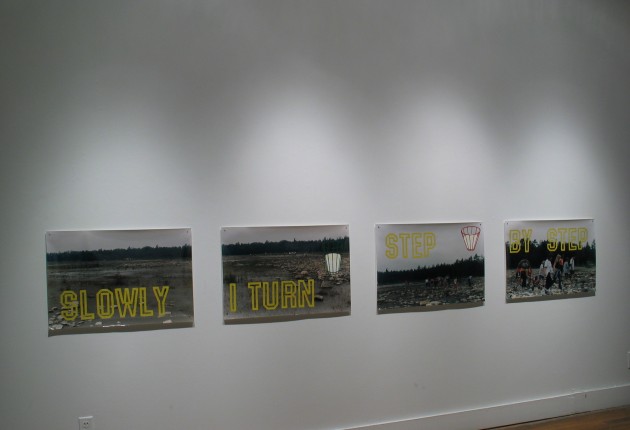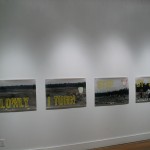Lakeshore consists of an ongoing series of one hundred 50 x 75-cm colour photographs with short texts or images painted on them in oils. The photographs serve as supports for the painting, and depict landscape, architecture and a variety of other subjects. The texts are predominantly in either English or French (as well as in German and Latin), and all the photographs are taken in Canada, France, Germany or Kenya. The painted texts recall the traditional role that captions play in the interpretation of photographs, used traditionally to direct the viewer to a specific message conveyed by the photograph. In this work, we are attempting to upend, extend and imbricate some of the conventions in painting, photography and language.
For Armstrong and Collins, lakeshore refers to Ontario’s myriad lakes in Ontario, and most immediately to Lake Ontario, the lake the artists both grew up beside. These lakes have served as motifs for important streams in nineteenth- and twentieth-century Canadian art; and, this is a backdrop to their work. Lakeshore also signifies an intermediary state, a space between two bodies, a space that has three possible reference points: a vanishing vista, a point of possible departure, a destination at the end of a voyage.
The artists have used the idea of lakeshore in a figurative and personal manner. Although some of the photographs do depict lakeshores, most have to do with our routine comings and goings, artistic and quotidian. The photographs are set in both rural and urban locations. Armstrong and Collins pointedly have not represented any lakes: this reinforces their metaphorical focus (and eases their task, as France has very few lakes). Their painted text passages are idiomatic and common expressions, maxims, and phrases from popular culture. The painted words do not serve as captions for the images, but rather further the artists’ exploration of the metaphorical idea of a lakeshore. The images painted on the photographs are of glasses, pails and basins of water, and offer the only explicit bodies of water in the artworks. The addition of the painted elements to the photographs creates a flicker effect between literal and figurative meaning, a semantic instability and indeterminacy.
Lakeshore has a second component: one hundred one- or two-paragraph texts on the theme of lakeshore that accompany an exhibition of the actual photographs in the form of a PowerPoint Show set on a continuous loop to be exhibited on a computer screen. The artists are working to publish an artist’s book with both reproductions of their painted photographs and one- or two-paragraph texts.
John Armstrong has exhibited his work in Toronto galleries such as The Robert Birch Gallery, YYZ and Cold City, as well as nationally and internationally. A 1998 survey exhibition of his artwork from the 1990s, titled “Sanguine,” was organized by Cambridge Galleries, and toured to the Owens Art Gallery, Sackville, New Brunswick, and Plug In ICA, Winnipeg.
Paul Collins, originally from Toronto, has lived and worked in Paris for 20 years, and has exhibited both in Canada and internationally. He has shown in Toronto at A Space, YYZ and Mercer Union, and in Paris at the Fondation Cartier and CREDAC as well as at the Musée des Beaux-arts de Mulhouse.


